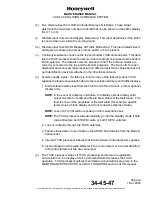
Page 56
1 Dec 2003
34-45-4
7
MAINTENANCE MANUAL
CAS-100 COLLISION AVOIDANCE SYSTEM
Use or disclosure of information on this page is subject to the restrictions in the proprietary notice of this document.
(j)
Display range limit control, ABOVE/NORM/BELOW nonthreat altitude display limit
control, and relative/flight level altitude display control data originating from the
transponder/TCAS control unit and received by the traffic display through the Mode S
transponder and TCAS processor.
(k)
Other strapped control data (For example, maximum number of intruders to be
shown)
Refer to Controls and Indicators, paragraph 7, for traffic display indications and
annunciations.
D. RA/VSI Display
The IVA-81B Resolution Advisory/Vertical Speed Indicator (RA/VSI) display. It consists of:
•
An electro-mechanically driven pointer (to show vertical speed)
•
A resolution advisory arc of red and green high intensity light-emitting diodes (LEDs)
•
An electro-mechanical TCAS flag (To show normal and fail conditions and RA mode
OFF conditions)
•
Vertical speed failure flag
The resolution advisory LEDs are installed below a coated surface which makes them not seen
when unlighted. The VSI face is matte black with a matte white vertical speed scale. The
vertical speed pointer is controlled by a two-phase motor. The position is controlled by the
processed data supplied by the display computer.
The RA/VSI accepts the air data ARINC 565 or ARINC 575 analog input, ARINC 575 digital,
ARINC 429 high and low speed data, or a pneumatic vertical speed input.
Vertical maneuvering resolution advisory data (RA data) is received through a high-speed
ARINC 429 data bus from the TCAS processor.
NOTE:
Traffic is not shown on an RA/VSI
.
Built-in test circuits continuously monitor for RA/VSI unit failures. Failure status is reported to
the TCAS processor through discrete DISPLAY VALID signal lines.
The resolution advisories (RAs) on the electrical/electro-mechanical display of the RA/VSI are
identical to the RAs on the LCD display of the TA/VSI [see paragraph 5.C.(2)].
















































